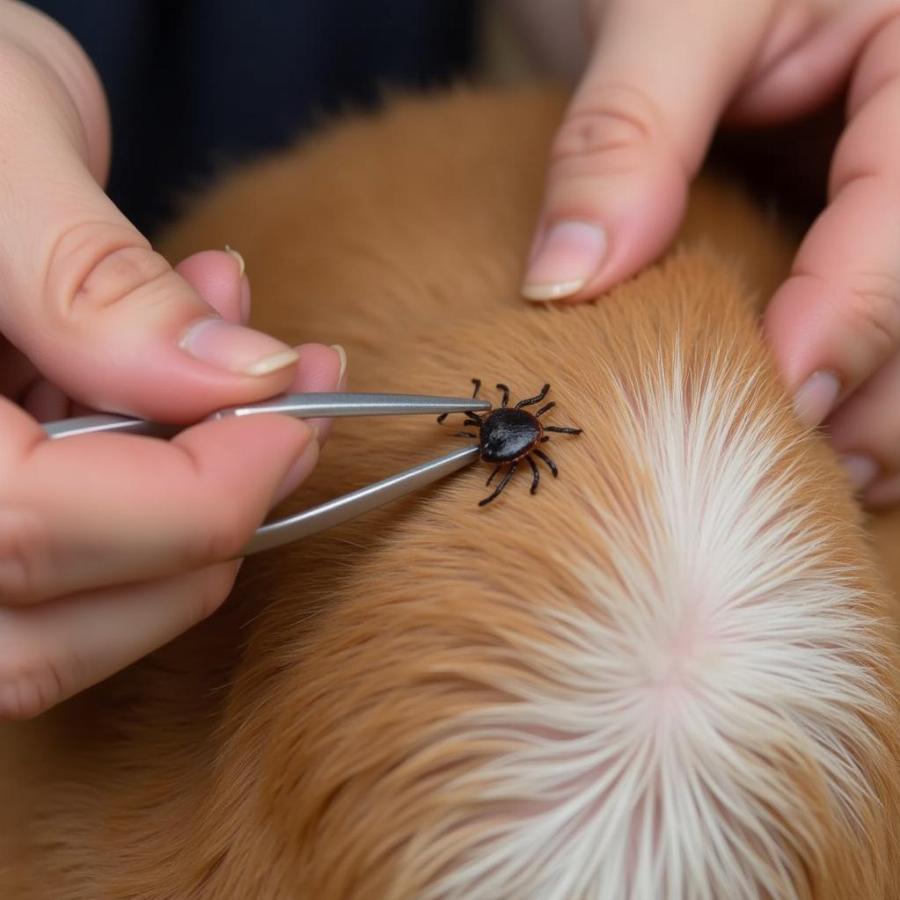Ticks are a common nuisance for dog owners, posing a threat of transmitting diseases like Lyme disease, ehrlichiosis, and Rocky Mountain spotted fever. Understanding how to repel ticks on dogs is crucial for maintaining their health and well-being. This article provides a comprehensive guide to effective tick prevention strategies, from natural remedies to commercial products.
Natural Ways to Repel Ticks on Dogs
Many pet owners prefer natural methods to repel ticks on dogs. These options can be less harsh than chemical treatments, but their effectiveness can vary.
Apple Cider Vinegar
Diluted apple cider vinegar can be sprayed on your dog’s fur. While not scientifically proven to repel ticks, some believe the altered pH of the skin makes it less appealing to these parasites.
Essential Oils
Certain essential oils, like lavender, citronella, and lemongrass, are believed to have tick-repelling properties. essential oils to repel ticks on dogs However, it’s essential to dilute them properly and consult with a veterinarian before use, as some oils can be toxic to dogs. is peppermint oil harmful to dogs
Tick-Repelling Plants
Planting tick-repelling plants in your yard, such as lavender, rosemary, and chrysanthemums, can help create a less tick-friendly environment. plants that repel ticks safe for dogs
Commercial Tick Prevention Products for Dogs
Commercial products offer a wider range of options for repelling ticks on dogs, with varying levels of effectiveness.
Tick Collars
Tick collars release chemicals that repel and kill ticks. They provide long-lasting protection, but some dogs may experience skin irritation.
Topical Treatments
Topical treatments are applied directly to the dog’s skin, usually between the shoulder blades. They offer quick and effective protection against ticks.
Oral Medications
Oral medications are administered monthly and kill ticks that bite the dog. They are highly effective but may have potential side effects.
How to Check Your Dog for Ticks
Regularly checking your dog for ticks is vital, even with preventative measures in place.
Where to Look
Focus on areas where ticks are likely to hide, such as the ears, neck, armpits, groin, and between the toes.
What to Do if You Find a Tick
Use tweezers to grasp the tick as close to the skin as possible and pull it straight out. Clean the area with antiseptic and monitor for any signs of infection.
 Removing a Tick from a Dog
Removing a Tick from a Dog
Best Heartworm and Flea and Tick Prevention for Dogs
For comprehensive protection, consider products that offer combined protection against heartworms, fleas, and ticks. best heartworm and flea and tick prevention for dogs
Homemade Flea and Tick Spray for Dogs
Some pet owners opt for homemade flea and tick sprays using natural ingredients. homemade flea spray for dogs These can be a cost-effective alternative but may not be as potent as commercial products.
Conclusion
Repelling ticks on dogs requires a multifaceted approach, combining preventative measures with regular checks. By understanding the various options available, from natural remedies to commercial products, you can choose the best strategy to protect your furry friend from these pesky parasites.
FAQ
-
How often should I check my dog for ticks? Daily checks are recommended, especially during tick season.
-
Are essential oils safe for all dogs? No, some essential oils can be toxic to dogs. Consult with a veterinarian before using them.
-
How effective are tick collars? Tick collars can be effective, but their efficacy varies depending on the brand and the dog.
-
What are the symptoms of tick-borne diseases in dogs? Symptoms can include fever, lethargy, loss of appetite, joint pain, and swollen lymph nodes.
-
Can I use human tick repellent on my dog? No, human tick repellents often contain ingredients that are toxic to dogs.
-
How can I make my yard less attractive to ticks? Keep your grass short, remove leaf litter, and create a barrier of wood chips or gravel around the perimeter of your yard.
-
What should I do if my dog develops a rash after being bitten by a tick? Consult with a veterinarian immediately, as this could be a sign of a tick-borne illness.
Beaut Dogs is your trusted source for all things dog-related, from breed information to expert advice on care and training. We provide a comprehensive resource for dog lovers, offering valuable insights into the wonderful world of canine companionship. For further assistance, please contact us at [email protected]. We at Beaut Dogs are here to answer your questions.